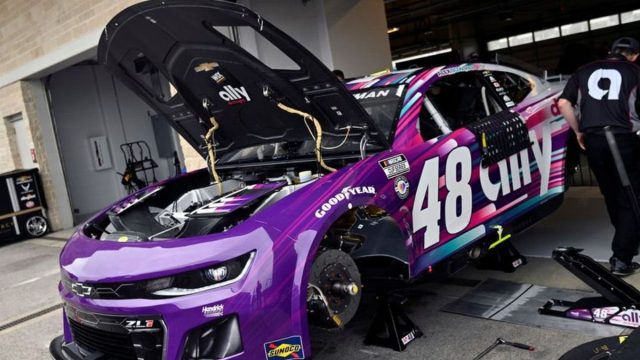The Biggest Fines in NASCAR History: The world of NASCAR is no stranger to penalties, but some fines have left the racing community in awe. These financial sanctions, often reaching staggering amounts, have not only made headlines but have also reshaped the sport’s landscape.
From the early days of NASCAR to the cutting-edge technology of today, the biggest fines in the sport’s history have not only sent shockwaves through the paddock but have also raised questions about the lengths teams are willing to go for a competitive edge.
The revelations behind these fines shed light on a hidden world within NASCAR, where the pursuit of victory can sometimes come at a hefty cost.
Introduction and Context of NASCAR Penalties
Frequently, in the realm of NASCAR racing, penalties play a crucial role in maintaining the integrity of the sport and upholding fair competition among teams and drivers. The stringent regulations of stock car racing, originating from the concept of using cars directly from the showroom, have spurred crew chiefs and mechanics to push the boundaries of innovation in enhancing car performance. These endeavours have led to instances where penalties are imposed to curb any attempts at gaining unfair advantages.
For example, the penalty imposed on Team Penske’s Joey Logano illustrates the significance of adherence to regulations. Logano was fined $10,000 for wearing webbed gloves during qualifying in Atlanta, a creative yet prohibited tactic aimed at restricting airflow into the cockpit to reduce drag. This incident underscores the fine line teams walk between innovation and rule-breaking in their quest for speed and performance. NASCAR penalties serve as a deterrent, ensuring that competition remains fair and that teams compete on a level playing field, ultimately preserving the integrity and spirit of the sport.

The First NASCAR Cheating Instance in 1949
The roots of NASCAR’s commitment to enforcing rules and maintaining fairness trace back to the inaugural ‘ strictly stock’ race in 1949, which revealed the sport’s first instance of cheating involving Glenn Dunaway’s victory in a car with illegal rear springs. Dunaway drove Herbert Westmoreland’s 1947 Ford, originally a moonshine runner, to finish three laps ahead of Jim Roper. However, post-race inspection uncovered the illegal rear springs, leading to Dunaway’s disqualification and relegation to the bottom of the results. The aftermath included a lawsuit that was subsequently dismissed, solidifying NASCAR founder Bill France Sr.’s authority in meeting out penalties.
Evolution of NASCAR Penalties: Next-Gen Cars and Severe Consequences
Unquestionably, the evolution of NASCAR penalties with the introduction of the Next Gen car in the 2022 season has significantly raised the stakes for teams and drivers, ushering in a new era of stricter consequences for rule violations. This shift has forced teams to navigate a more complex landscape of regulations and repercussions, particularly focusing on the manipulation of single-source-supplied parts. Here are some key points highlighting the impact of this evolution:
- Revoked Playoff Eligibility: Violations related to modifying single-source supplied parts can now lead to the revocation of playoff eligibility, adding a significant deterrent for teams.
- Costly Exercises: Teams are still testing the boundaries despite the stricter penalties, resulting in costly endeavours to push the limits.
- Reduced Individual Development: The Next Gen car’s reliance on single-source supplied parts has reduced the need for individual team development efforts.
- Increased Scrutiny: The heightened consequences have led to increased scrutiny of teams, especially the prominent ones, as they navigate the fine line between innovation and violation.
The Biggest Fine in NASCAR History: The Hendrick Motorsports Case
Amidst the competitive landscape of NASCAR, the Hendrick Motorsports case stands out as a significant milestone due to the unprecedented magnitude of the fine imposed by NASCAR. In March 2023, NASCAR penalized five Cup Series teams, including all four Hendrick Motorsports cars and one from Kaulig Racing, for the unapproved modification of a single-source part—the hood louvres.
The violation, categorized as a Level 2 transgression in NASCAR’s rulebook, involved the “unapproved modification of a single-source vendor-supplied part (hood louvers).” Following the penalties, the teams opted to appeal the decision. Subsequently, a three-member National Motorsports Appeals Panel partially reduced the severe penalties initially imposed by NASCAR. This incident not only highlighted the importance of adherence to NASCAR’s regulations but also shed light on the consequences of non-compliance in a sport where precision and fairness are paramount.
| Team | Penalty Description | Outcome |
|---|---|---|
| Hendrick Motorsports | Unapproved modification of hood louvres | Fine partially reduced |
| Kaulig Racing | Unapproved modification of hood louvres | Penalty upheld |
Further Instances and the Biggest Single Fine in NASCAR History
Following the recent surge in significant penalties within the realm of NASCAR regulations, the sport witnessed its largest single fine to date in May 2023, marking a pivotal moment in the enforcement of compliance measures within the racing community. This historic event unfolded when NASCAR imposed its first-ever L3-level penalty against Stewart-Haas Racing’s Chase Briscoe and the No. 14 team for utilizing counterfeit parts on the Next Gen car. The repercussions of this violation reverberated throughout the racing world, underscoring the importance of upholding the integrity of the sport. Notably, this incident surpassed all previous fines in NASCAR’s history, solidifying its stance on maintaining fairness and adherence to the rules.
The introduction of the L3-level penalty raised the stakes for teams engaging in rule violations. Stewart-Haas Racing faced unprecedented consequences for their actions.
The incident shed light on the meticulous scrutiny applied to ensure compliance with regulations. NASCAR’s unwavering commitment to preserving the sport’s integrity was evident in this landmark fine.

News in Brief
ALSO READ: Joey Logano Faces NASCAR Penalty: Shocking Revelations Unveiled
